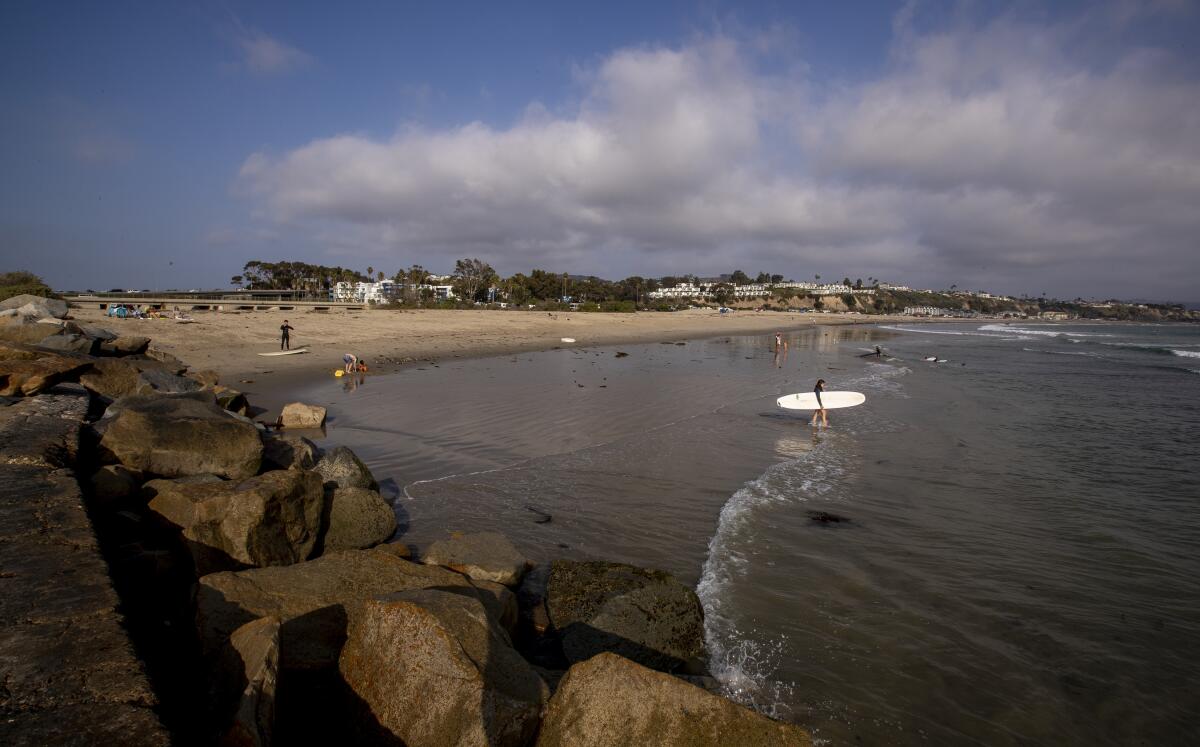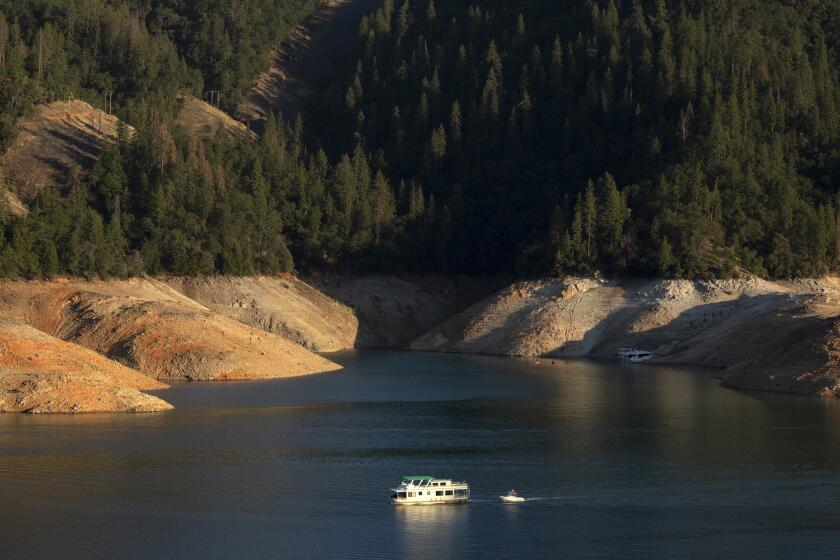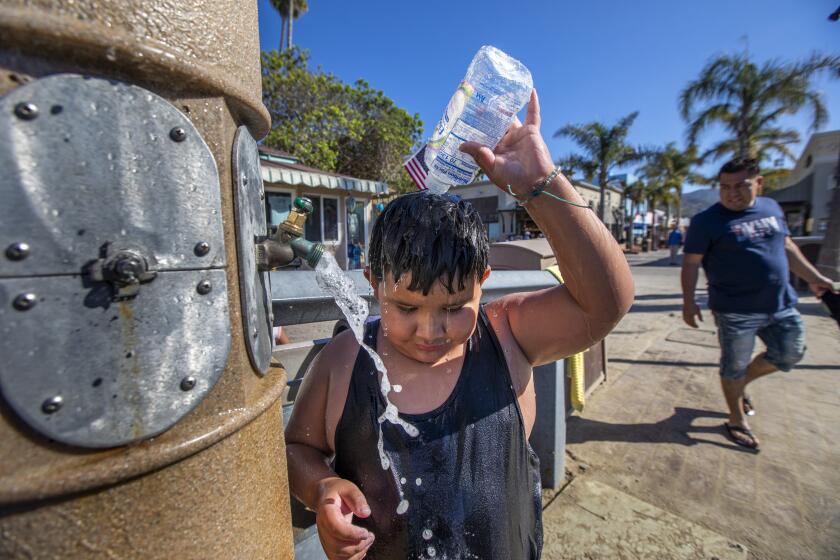California Coastal Commission OKs desalination plant in Orange County

- Share via
Less than six months after rejecting a proposal for a major desalination plant in Huntington Beach, the California Coastal Commission on Thursday approved plans for a different, smaller project in Orange County that could serve as a model for future projects.
The commission gave unanimous approval — with conditions — to the Doheny Ocean Desalination Project near Pacific Coast Highway and San Juan Creek in Dana Point. The facility, which will convert seawater to drinking water, will be operated by the South Coast Water District.
Unlike the Poseidon Water project, which was rejected in May because of dangers it posed to marine life and other issues, the Doheny plant will tie in to an existing municipal system and feature a better environmental design, officials said. But while some championed the project as an example of desalination “done right,” opponents said there are more efficient and economical methods that should be explored first.
Kate Huckelbridge, the Coastal Commission’s senior deputy director, said in an interview before the meeting that Doheny cleared many of the hurdles that come with desalination and “represents an easier pathway to an approvable project.”
“We have really significant water problems in the state, and so I think we’re in a situation where we need to be really serious about investigating all of the options,” she said.
After hours of intense debate Thursday, coastal regulators have rejected Poseidon Water’s proposal to build a desalination plant in Huntington Beach.
South Coast Water District officials said the project is coming at a crucial time. The agency — which serves about 40,000 residents and 2 million visitors each year — currently imports 90% of its supplies from the State Water Project and the Colorado River, both of which are shrinking because of drought, climate change and growing aridification.
There are also five fault lines between the district and its supply, which could jeopardize water deliveries in the event of an earthquake, said Rick Shintaku, general manager of the water district.
“That is a huge threat for us, if one of those fault lines were to rupture the feeders or the plant up there,” he said. “Our regional planning agency has told us to plan for 60 days’ supply in an emergency. We have 11 right now.”
When completed in 2027, the desalination plant will have the capacity to produce up to 5 million gallons of potable water per day, enough to slash the district’s reliance on imported water from 90% to “anywhere from 20% to 40%,” Shintaku said.
But desalination is not without controversy, and the commission’s approval came with more than a dozen conditions that the water district must meet, including working with the California Department of Parks and Recreation to locate new campsites while construction shuts down the Doheny State Beach campground for 18 to 24 months.

The project also includes several design elements intended to address potential harms to marine life — typically seen as one of the biggest downsides of the desalination process.
Under the proposed plans, seawater will be pumped into the facility through fully submerged, slanted intake wells that will run beneath Doheny State Beach. The low-velocity wells will never reach the surface, and therefore won’t trap any marine life, according to the water district.
The other end of the process involves the discharge of hypersaline brine, or the salty water that is removed from seawater during desalination. Brine from Doheny will be commingled with the water district’s existing wastewater lines and diluted before it is expelled about two miles out to sea.
The result is not zero harm, but it is significantly less than that of a project like Poseidon and is the “environmentally preferred discharge method,” officials said. The commission is also requiring that the water district create or restore about 7½ acres of tidal wetlands elsewhere in the county as compensation for any potential losses.
“I see this project as the model that I hope all applicants will aspire to,” commission Chair Donne Brownsey said during the meeting.
Residents are conserving water at a commendable pace, but officials say warmer and drier conditions await.
The project has gained broad support from local elected officials, including Reps. Mike Levin (D-San Juan Capistrano) and Michelle Steel (R-Seal Beach), and agencies such as the Metropolitan Water District and the San Diego Regional Water Quality Board, which called it “the first ocean desalination facility that eliminates harm to fish.” The city of San Clemente and the Laguna Beach County Water District have both signed letters of interest in partnering on the project.
Reached by phone, Orange County Coastkeeper President Garry Brown — who fought against the Poseidon project for nearly 20 years — said he supported the South Coast Water District’s plan because it “totally complied” with the statewide desalination policy under the California Ocean Plan.
“We had this project that 100% complied with the statewide policy, and we had Poseidon, which almost 100% did not comply,” he said. “The South Coast plant was a project done right, and Poseidon was desal done wrong.”
Brown noted that his support was based on the project’s technical design, which not only mitigates effects on marine life but also seeks to reduce energy costs through solar power. He had not reviewed the project for its compliance with the California Coastal Act — a separate document that considers public impact — and so was neutral on that aspect.
Some locals, however, did have concerns. Connor Everts, executive director of the Southern California Watershed Alliance, said he opposed the project because he did not think the water district had done enough around water conservation and reclamation.
“The reality is we save more water than these plants produce,” he said. “When we save water, we save energy and we don’t harm the environment.”
Lydia Ponce, an activist with the Society of Native Nations, said similarly that she was concerned about the long-term environmental effects of the brine discharge. She said officials should have exhausted all other options first.
“We’re nowhere near using desalination as a solution,” she said. “It’s too much of a commodity to be able to say ‘the future of water is desalination.’ No, the future of water is conservation, reuse and redirecting, repurposing.”
Commissioner Effie Turnbull-Sanders acknowledged that continued focus on those efforts is needed.
“However, in the current environment, we do have a significant need for additional water in our portfolio,” she said. “And I do believe that this project ... is much better than the ones we have seen in the past.”
On Catalina Island, desalination technology is helping humans cope with a dwindling water supply. Wildlife, however, is feeling the pain.
Shintaku said the district has been in Level 2 of its water conservation plan since May, and also has one of the lowest water loss rates in the state, around 3% to 4%. He also said that the district has been investing in recycled water for about four decades, and that one of its wastewater treatment plants is already reusing 70% of its sewage, with a goal of getting to 100%.
“We did everything else possible — from recycled water to conservation to minimizing our system water losses to [treating] brackish groundwater,” he said. “And then we still are stuck in this predicament, with being 90% dependent on Metropolitan for drinking water supplies.”
In the case of Poseidon, opponents were also concerned about the profit structure, including what they described as the “privatization of water” for the politically powerful Poseidon Water.
Doheny’s added cost to ratepayers will depend on the partnership structure. If the water district goes it alone, the $140-million project would add about $7 a month to an average household bill, Shintaku said. If other water districts sign on, that cost would drop to $2.38.
“There’s no question that meeting California’s future water needs is a challenge that will require all the tools in the toolbox,” Huckelbridge told commissioners during the meeting. “We believe that the project before you today, although not perfect, provides a solid example that we can use in planning for future desalination.”
Doheny will join a growing list of desalination plants in California, including already operational plants in Santa Barbara and Carlsbad. Santa Catalina Island, off the coast of Los Angeles, today receives about half of its water from a desalination facility on its shore.
More to Read
Sign up for Essential California
The most important California stories and recommendations in your inbox every morning.
You may occasionally receive promotional content from the Los Angeles Times.

















